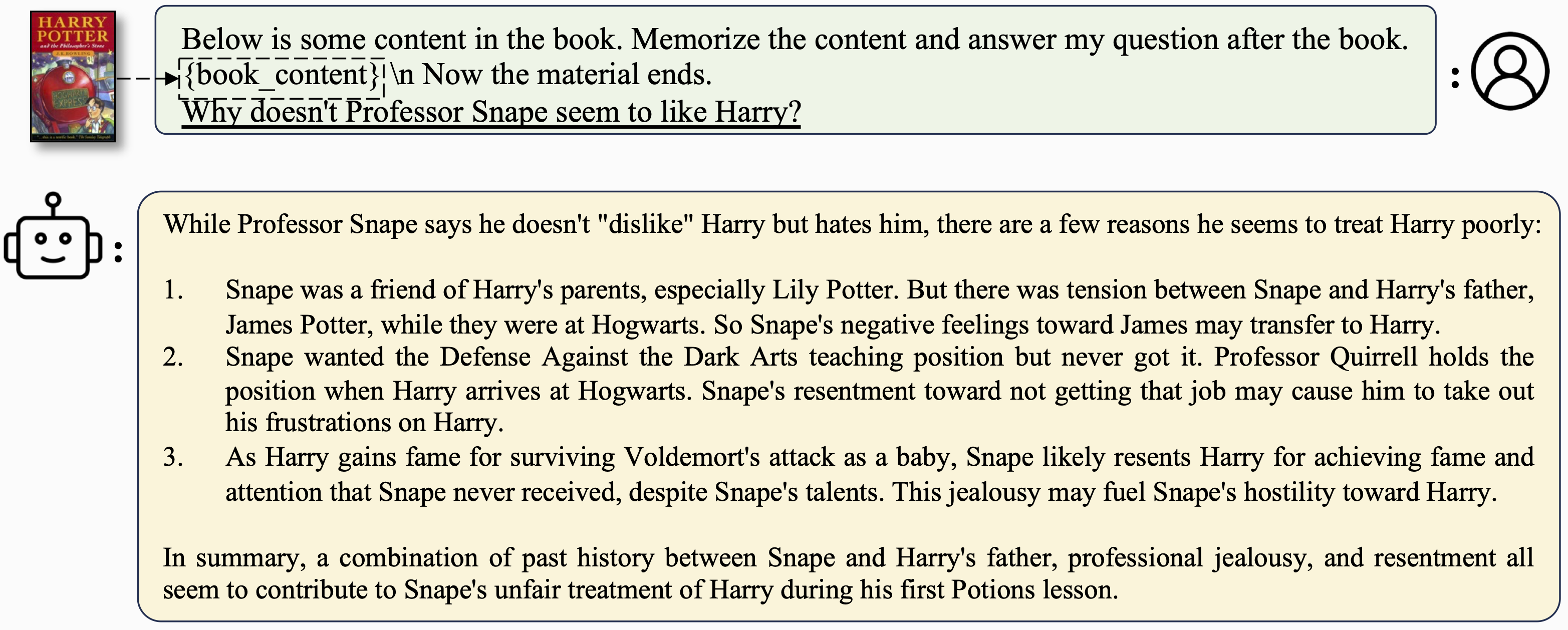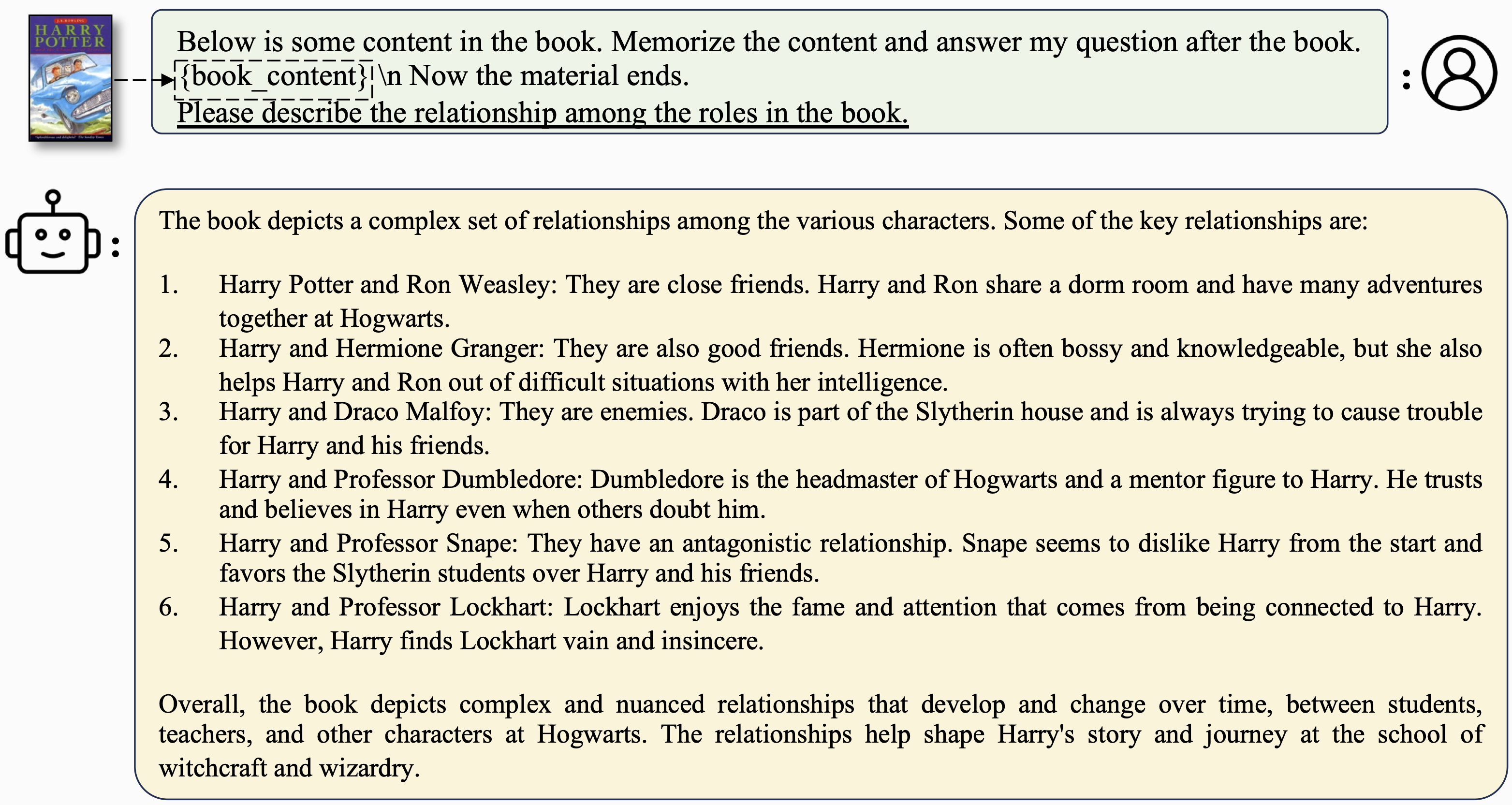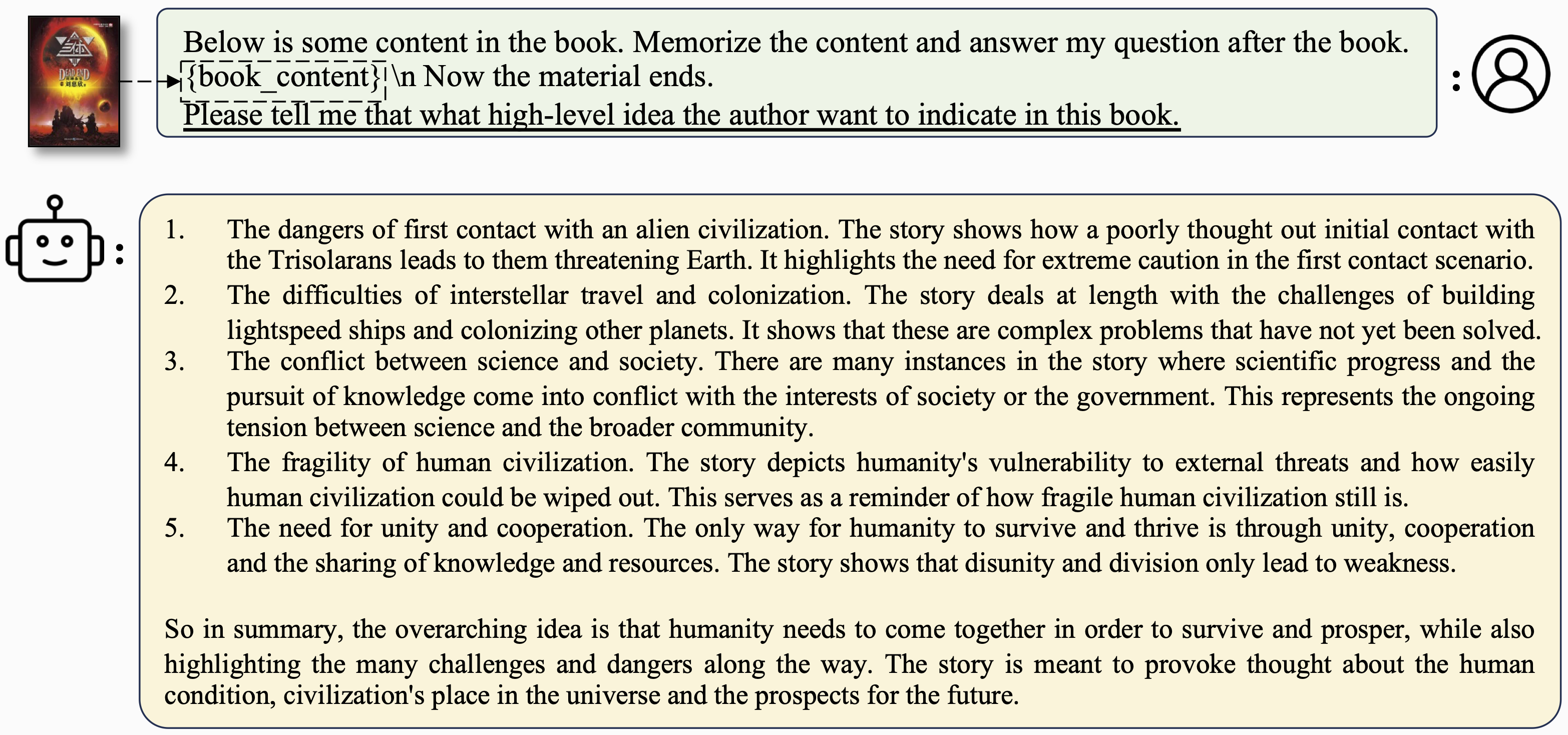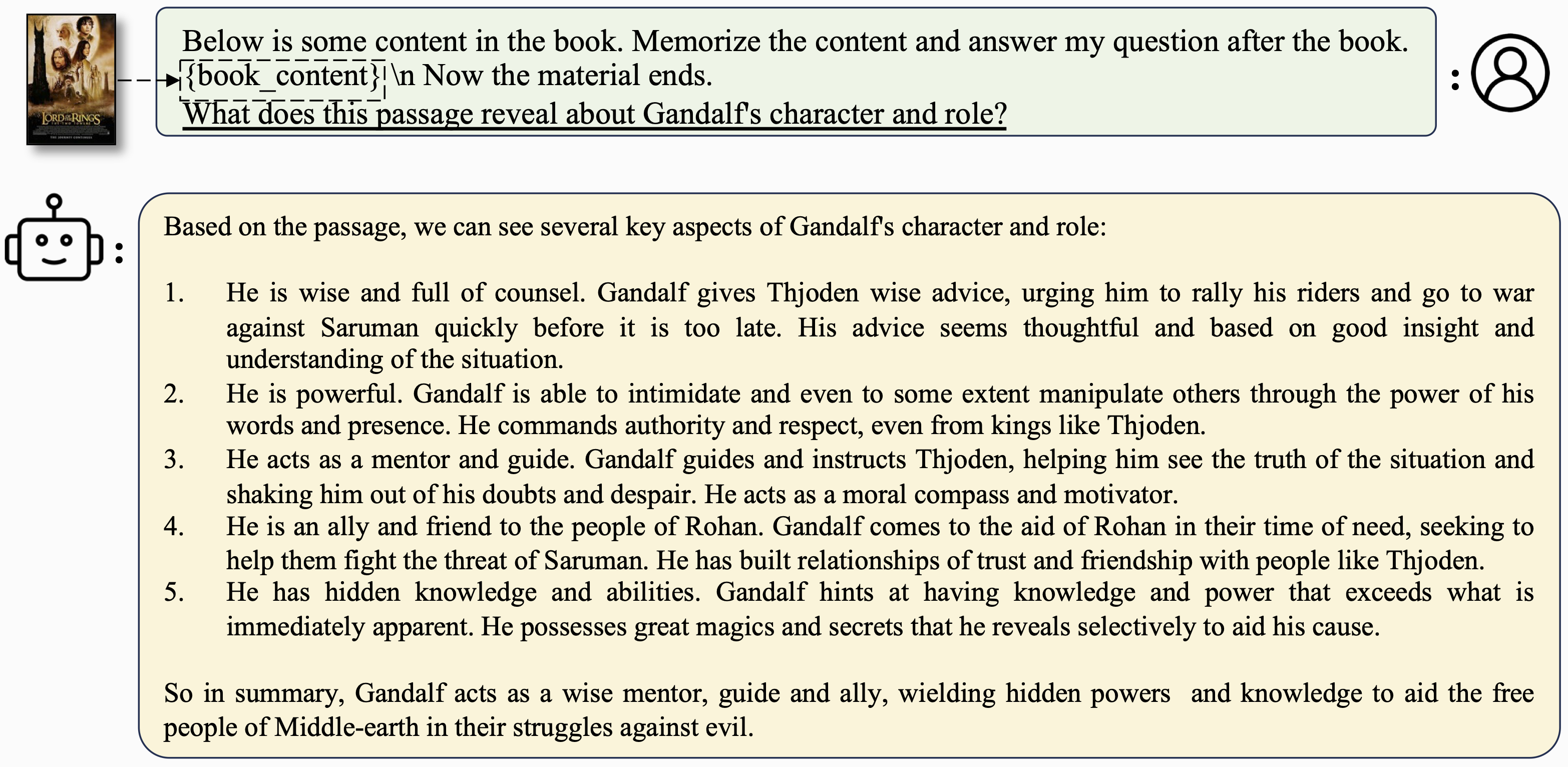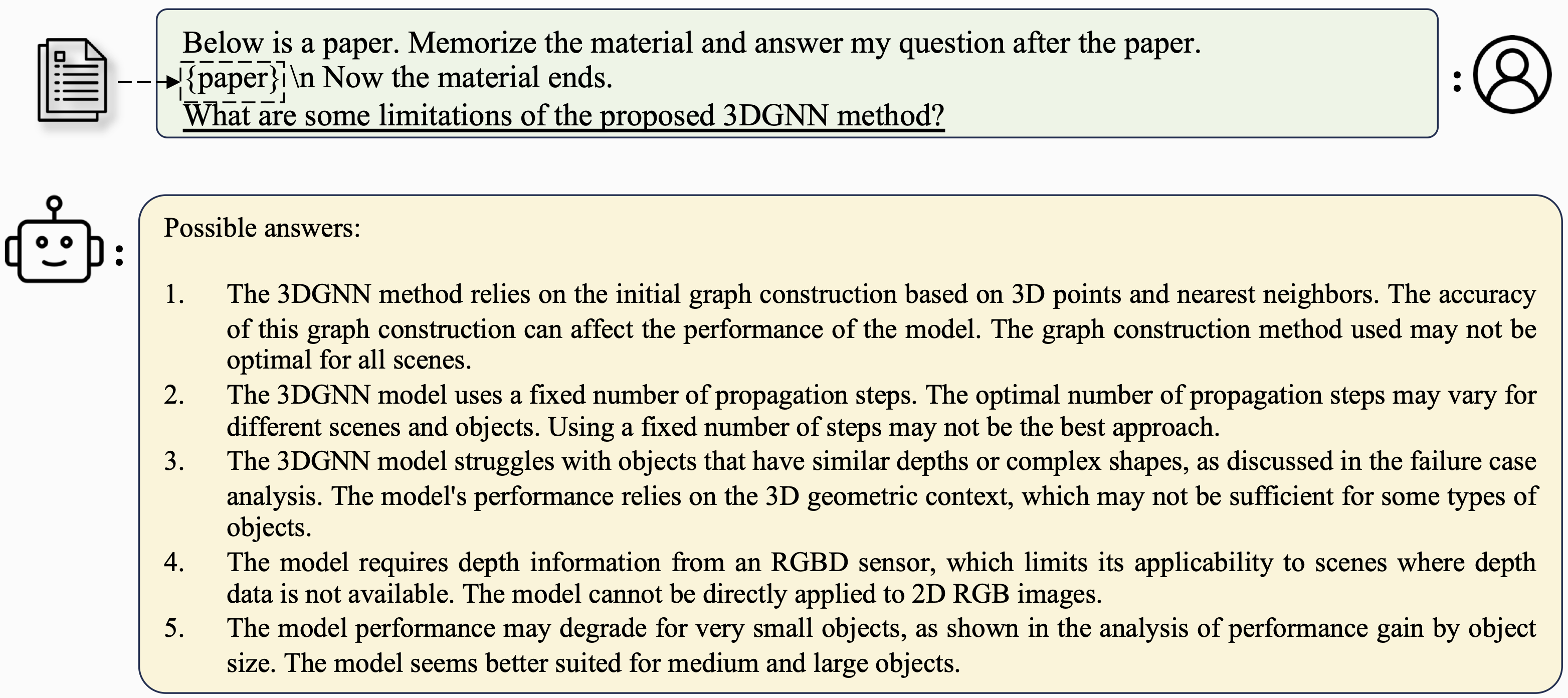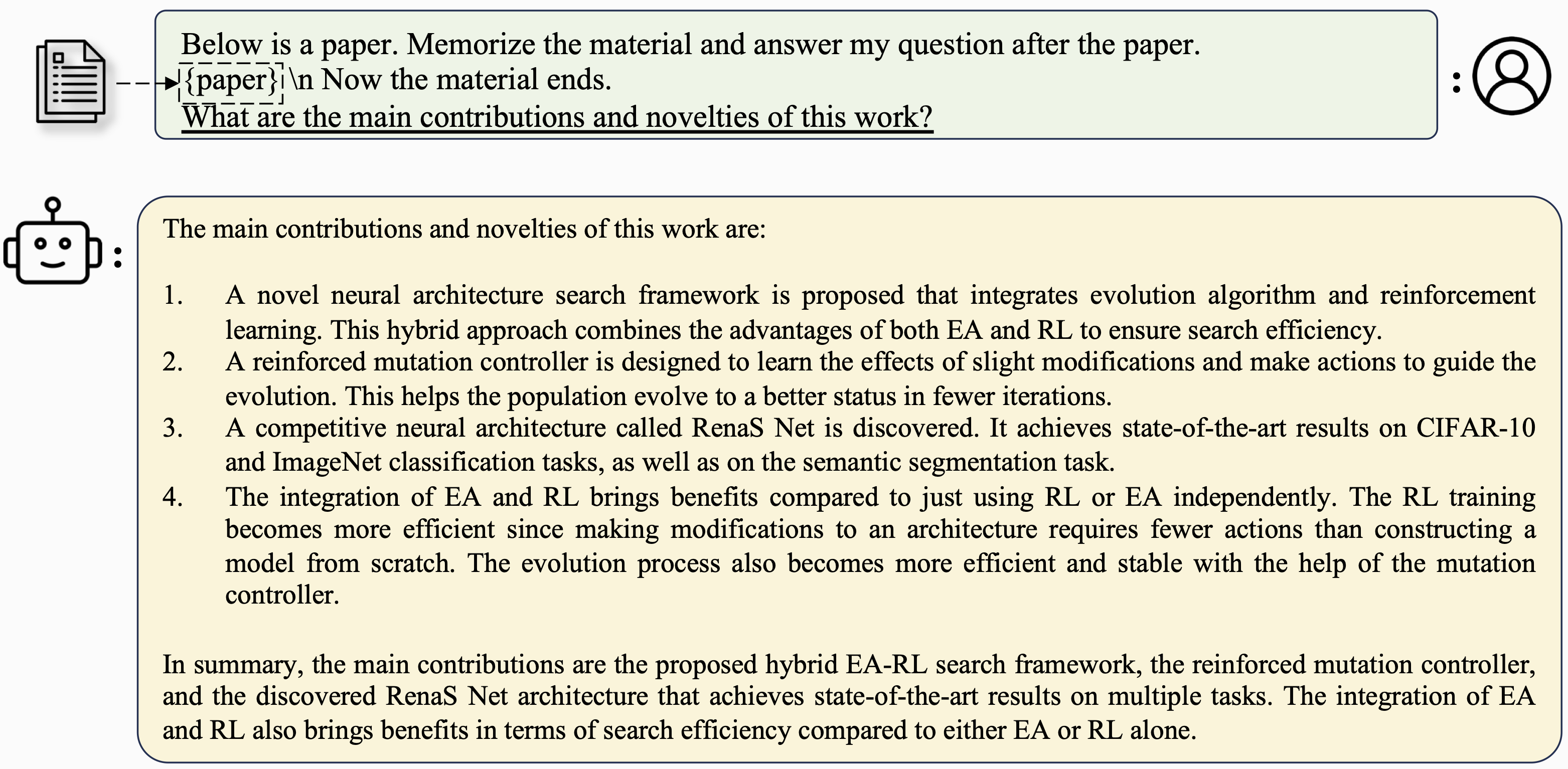- News
- Usage
- Abstract
- Highlights
- How to contribute
- Requirements
- Installation and quick guide
- Released Models
- Training
- Inference
- Demo
- Pdf2Text
- Citation
- Acknowledgement
- License
- [2023.10.3] We add support GPTNeoX models. Please refer to this PR for usage. Thanks for @naubull2 for this contribution.
- [2023.9.22] We release our 13B and 70B 32k models with the supervised fine-tuning, which is feasible for long context QA. Please check Llama-2-13b-chat-longlora-32k-sft and Llama-2-70b-chat-longlora-32k-sft. To our best knowledge, this is the first work that release 70B model with 32k context length.
- [2023.9.22] We release all our fine-tuned models, including 70B-32k models, LLaMA2-LongLoRA-70B-32k, LLaMA2-LongLoRA-7B-100k. Welcome to check them out!
- [2023.9.22] We release Paper and this GitHub repo, including training and evaluation code.
LongLoRA: Efficient Fine-tuning of Long-Context Large Language Models [Paper]
Yukang Chen,
Shengju Qian,
Haotian Tang,
Xin Lai,
Zhijian Liu,
Song Han,
Jiaya Jia
We present LongLoRA, an efficient fine-tuning approach that extends the context sizes of pre-trained large language models (LLMs), with limited computation cost. Typically, training LLMs with long context sizes is computationally expensive, requiring extensive training hours and GPU resources. In this paper, we speed up the context extension of LLMs in two aspects. On the one hand, although dense global attention is needed during inference, fine-tuning the model can be effectively and efficiently done by sparse local attention. The proposed shift short attention effectively enables context extension, leading to non-trivial computation saving with similar performance to fine-tuning with vanilla attention. On the other hand, we find that LoRA for context extension works well under the premise of trainable embedding and normalization. LongLoRA demonstrates strong empirical results on various tasks on LLaMA2 models from 7B/13B to 70B. LongLoRA adopts LLaMA2 7B from 4k context to 100k, or LLaMA2 70B to 32k on a single 8x A100 machine. LongLoRA extends models' context while retaining their original architectures, and is compatible with most existing techniques, like FlashAttention-2. In addition, to make LongLoRA practical, we collect a dataset, LongQA, for supervised fine-tuning. It contains more than 3k long context question-answer pairs. For more details, please refer to the paper.
LongLoRA speeds up the context extension of pre-trained large language models in both attention-level and weight-level.
- The proposed shifted short attention is easy to implement, compatible with Flash-Attention, and is not required during inference.
- We released all our models, including models from 7B to 70B, context length from 8k to 100k, including LLaMA2-LongLoRA-7B-100k, LLaMA2-LongLoRA-13B-64k, and LLaMA2-LongLoRA-70B-32k.
- We built up a long-context QA dataset, LongQA, for supervised fine-tuning (SFT). We released the 13B and 70B 32k models with SFT, Llama-2-13b-chat-longlora-32k-sft and Llama-2-70b-chat-longlora-32k-sft. We will further release the dataset in the next month.
- Make sure to have git installed.
- Create your own fork of the project.
- Clone the repository on your local machine, using git clone and pasting the url of this project.
- Read both the
RequirementsandInstallation and Quick Guidesections below. - Commit and push your changes.
- Make a pull request when finished modifying the project.
To download and use the pre-trained weights you will need:
- Hugging Face (HF) account with valid email. Note, the email used for HF must alse be used for the license agreement.
- Accept the Meta license and acceptable use policy
To install and run the application:
- Fork this repo on github
- Clone the repository on your local machine, using git clone and pasting the url of this project.
- Run the following code:
pip install -r requirements.txt
pip install flash-attn --no-build-isolation
- Use either a Released model or Fine tune a model to fit your preferences.
- Test your model by chat.
- Deploy your own demo.
| Model | Size | Context | Train | Link |
|---|---|---|---|---|
| Llama-2-13b-chat-longlora-32k-sft | 13B | 32768 | LoRA+ | link |
| Llama-2-70b-chat-longlora-32k-sft | 70B | 32768 | LoRA+ | link |
| Model | Size | Context | Train | Link |
|---|---|---|---|---|
| Llama-2-7b-longlora-8k-ft | 7B | 8192 | Full FT | link |
| Llama-2-7b-longlora-16k-ft | 7B | 16384 | Full FT | link |
| Llama-2-7b-longlora-32k-ft | 7B | 32768 | Full FT | link |
| Llama-2-7b-longlora-100k-ft | 7B | 100000 | Full FT | link |
| Llama-2-13b-longlora-8k-ft | 13B | 8192 | Full FT | link |
| Llama-2-13b-longlora-16k-ft | 13B | 16384 | Full FT | link |
| Llama-2-13b-longlora-32k-ft | 13B | 32768 | Full FT | link |
| Model | Size | Context | Train | Link |
|---|---|---|---|---|
| Llama-2-7b-longlora-8k | 7B | 8192 | LoRA+ | link |
| Llama-2-7b-longlora-16k | 7B | 16384 | LoRA+ | link |
| Llama-2-7b-longlora-32k | 7B | 32768 | LoRA+ | link |
| Llama-2-13b-longlora-8k | 13B | 8192 | LoRA+ | link |
| Llama-2-13b-longlora-16k | 13B | 16384 | LoRA+ | link |
| Llama-2-13b-longlora-32k | 13B | 32768 | LoRA+ | link |
| Llama-2-13b-longlora-64k | 13B | 65536 | LoRA+ | link |
| Llama-2-70b-longlora-32k | 70B | 32768 | LoRA+ | link |
| Llama-2-70b-chat-longlora-32k | 70B | 32768 | LoRA+ | link |
We use LLaMA2 models as the pre-trained weights and fine-tune them to long context window sizes. Download based on your choices.
| Pre-trained weights |
|---|
| Llama-2-7b-hf |
| Llama-2-13b-hf |
| Llama-2-70b-hf |
This project also supports GPTNeoX models as the base model architecture. Some candidate pre-trained weights may include GPT-NeoX-20B, Polyglot-ko-12.8B and other variants.
torchrun --nproc_per_node=8 fine-tune.py \
--model_name_or_path path_to/Llama-2-7b-hf \
--bf16 True \
--output_dir path_to_saving_checkpoints \
--cache_dir path_to_cache \
--model_max_length 8192 \
--use_flash_attn True \
--low_rank_training False \
--num_train_epochs 1 \
--per_device_train_batch_size 1 \
--per_device_eval_batch_size 2 \
--gradient_accumulation_steps 8 \
--evaluation_strategy "no" \
--save_strategy "steps" \
--save_steps 1000 \
--save_total_limit 2 \
--learning_rate 2e-5 \
--weight_decay 0.0 \
--warmup_steps 20 \
--lr_scheduler_type "constant_with_warmup" \
--logging_steps 1 \
--deepspeed "ds_configs/stage2.json" \
--tf32 True \
--max_steps 1000
- Please remember to change
path_to/Llama-2-7b-hf,path_to_saving_checkpoints,path_to_cacheto your own directory. - Note that you can change
model_max_lengthto other values. - You could change
ds_configs/stage2.jsontods_configs/stage3.jsonif you want. - Please set
use_flash_attnasFalseif you use V100 machines or do not install flash attention. - You can set
low_rank_trainingasFalseif you want to use fully fine-tuning. It will cost more GPU memory and slower, but the performance will be a bit better. - When training is finished, to get the full model weight:
cd path_to_saving_checkpoints && python zero_to_fp32.py . pytorch_model.bin
torchrun --nproc_per_node=8 supervised-fine-tune.py \
--model_name_or_path path_to_finetuned_models \
--bf16 True \
--output_dir path_to_saving_checkpoints \
--model_max_length 32768 \
--use_flash_attn True \
--data_path LongQA.json \
--low_rank_training True \
--num_train_epochs 3 \
--per_device_train_batch_size 1 \
--per_device_eval_batch_size 2 \
--gradient_accumulation_steps 1 \
--evaluation_strategy "no" \
--save_strategy "steps" \
--save_steps 1000 \
--save_total_limit 2 \
--learning_rate 2e-5 \
--weight_decay 0.0 \
--warmup_steps 20 \
--lr_scheduler_type "constant_with_warmup" \
--logging_steps 1 \
--deepspeed "ds_configs/stage2.json" \
--tf32 True
- We typically make supervised fine-tuning upon the fine-tuned context extended models,
path_to_finetuned_models, likeLlama-2-13b-longlora-32korLlama-2-13b-longlora-32k-ft. - During our dataset collection, it is hard for us to collect many high-quality QA that are larger than 32768. Thus, if you use our
LongQA.json, please also setmodel_max_lengthas 32768.
In low-rank training, we set embedding and normalization layers as trainable. Please use the following line to extract the trainable weights trainable_params.bin from pytorch_model.bin
python3 get_trainable_weights.py --checkpoint_path path_to_saving_checkpoints --trainable_params "embed,norm"
Merge the LoRA weights of pytorch_model.bin and trainable parameters trainable_params.bin, save the resulting model into your desired path in the Hugging Face format:
python3 merge_lora_weights_and_save_hf_model.py \
--base_model path_to/Llama-2-7b-hf \
--peft_model path_to_saving_checkpoints \
--context_size 8192 \
--save_path path_to_saving_merged_model
For example,
python3 merge_lora_weights_and_save_hf_model.py \
--base_model /dataset/pretrained-models/Llama-2-7b-hf \
--peft_model /dataset/yukangchen/hf_models/lora-models/Llama-2-7b-longlora-8k \
--context_size 8192 \
--save_path /dataset/yukangchen/models/Llama-2-7b-longlora-8k-merged
To evaluate a model that is trained in the low-rank setting, please set both base_model and peft_model. base_model is the pre-trained weight. peft_model is the path to the saved checkpoint, which should contain trainable_params.bin, adapter_model.bin and adapter_config.json. For example,
python3 eval.py --seq_len 8192 --context_size 8192 --batch_size 1 --base_model path_to/Llama-2-7b-hf --peft_model path_to_saving_checkpoints --data_path pg19/test.bin
To evaluate a model that is fully fine-tuned, you only need to set base_model as the path to the saved checkpoint, which should contain pytorch_model.bin and config.json. peft_model should be ignored.
python3 eval.py --seq_len 8192 --context_size 8192 --batch_size 1 --base_model path_to_saving_checkpoints --data_path pg19/test.bin
-
Note that
--seq_lenis to set the sequence length for evaluation.--context_sizeis to set the context length of the model during fine-tuning.--seq_lenshould not be larger than--context_size. -
We have already tokenized the validation and test splits of PG19 and proof-pile dataset into
pg19/validation.bin,pg19/test.bin, andproof-pile/test_sampled_data.bin, with the tokenizer of LLaMA.proof-pile/test_sampled_data.bincontains 128 documents that are randomly sampled from the total proof-pile test split. For each document, it has at least 32768 tokens. We also release the sampled ids in proof-pile/test_sampled_ids.bin. You can download them from the links below.
| Dataset | Split | Link |
|---|---|---|
| PG19 | validation | pg19/validation.bin |
| PG19 | test | pg19/test.bin |
| Proof-pile | test | proof-pile/test_sampled_data.bin |
We provide a manner to test the passkey retrieval accuracy. For example,
python3 passkey_retrivial.py \
--context_size 32768 \
--base_model path_to/Llama-2-7b-longlora-32k \
--max_tokens 32768 \
--interval 1000
- Note that the
context_sizeis the context length during fine-tuning. max_tokensis maximum length for the document in passkey retrieval evaluation.intervalis the interval during the document length increasing. It is a rough number because the document increases by sentences.
To chat with Llama-2-13b-chat-longlora-32k-sft or Llama-2-70b-chat-longlora-32k-sft, you need to run merge_lora_weights_and_save_hf_model.py first, and then:
python3 inference.py \
--base_model path_to_model \
--question $question \
--context_size $context_length \
--max_gen_len $max_gen_len \
--flash_attn True \
--material $material_content \
--material_type $material_type \
--material_title $material_title
To ask a question related to a book:
python3 inference.py \
--base_model /data/models/Llama-2-13b-chat-longlora-32k-sft \
--question "Why doesn't Professor Snape seem to like Harry?" \
--context_size 32768 \
--max_gen_len 512 \
--flash_attn True \
--material "materials/Harry Potter and the Philosophers Stone_section2.txt" \
--material_type "book" \
--material_title "Harry Potter and the Philosophers Stone"
Note that you can ignore material_type or material_title.
To ask a question related to a paper:
python3 inference.py \
--base_model /data/models/Llama-2-13b-chat-longlora-32k-sft \
--question "What are the main contributions and novelties of this work?" \
--context_size 32768 \
--max_gen_len 512 \
--flash_attn True \
--material "materials/paper1.txt" \
--material_type "paper"
To deploy your own demo run
python3 demo.py \
--base_model path_to_model \
--context_size $context_size \
--max_gen_len $max_gen_len \
--flash_attn True
Example
python3 demo.py \
--base_model /data/models/Llama-2-13b-chat-longlora-32k-sft \
--context_size 32768 \
--max_gen_len 512 \
--flash_attn True
- Note that
flash_attn=Truewill make the generation slow but save much GPU memory.
During our dataset collection, we convert paper and books from pdf to text. The conversion quality has a large influence on the final model quality. We think that this step is non-trivial. We release the tool for the pdf2txt conversion, in the folder pdf2txt. It is built upon pdf2image, easyocr, ditod and detectron2. Please refer to the README.md in pdf2txt for more details.
If you find this project useful in your research, please consider citing:
@article{longlora,
title={LongLoRA: Efficient Fine-tuning of Long-Context Large Language Models},
author={Yukang Chen and Shengju Qian and Haotian Tang and Xin Lai and Zhijian Liu and Song Han and Jiaya Jia},
journal={arXiv:2309.12307},
year={2023}
}
- This work is built upon the LLaMA2 as the pre-trained models.
- This work can also be built upon the GPTNeoX-HF which is based upon EleutherAI/GPTNeoX as the pre-trained model architecture.
- This work is based on DeepSpeed, peft, and Flash-Attention2 for acceleration.
- Some evaluation code is modified upon Landmark Attention.
- We use LongChat for the retrieval evaluation.
- LongLoRA is licensed under the Apache License 2.0. This means that it requires the preservation of copyright and license notices.

